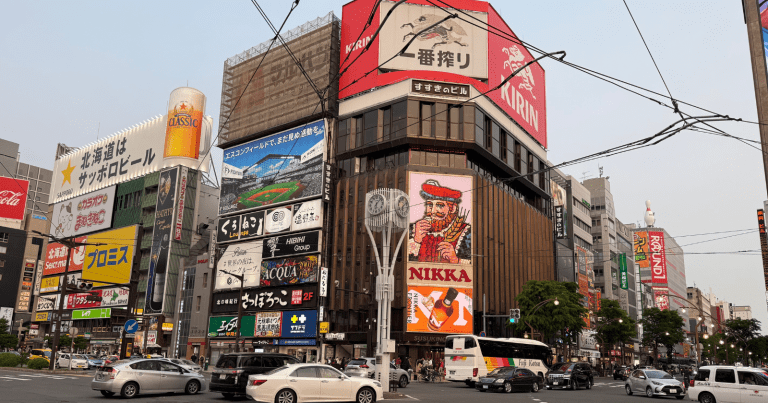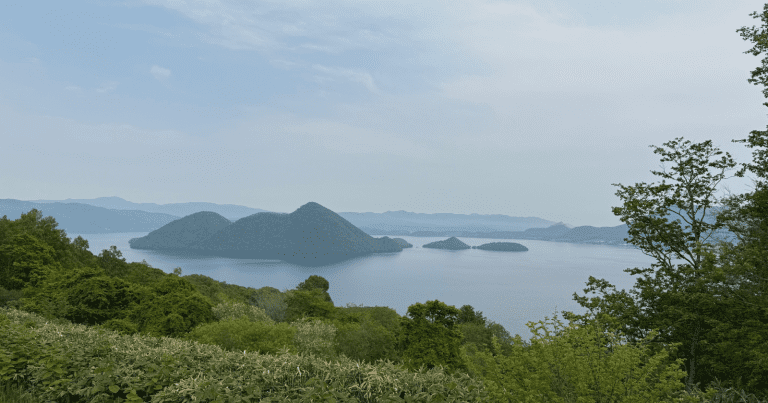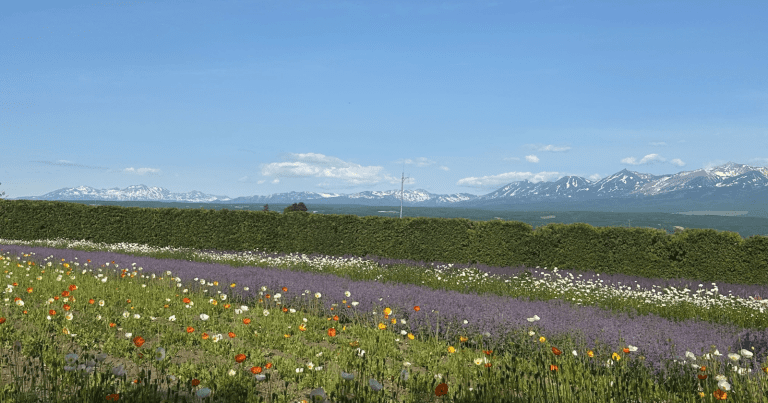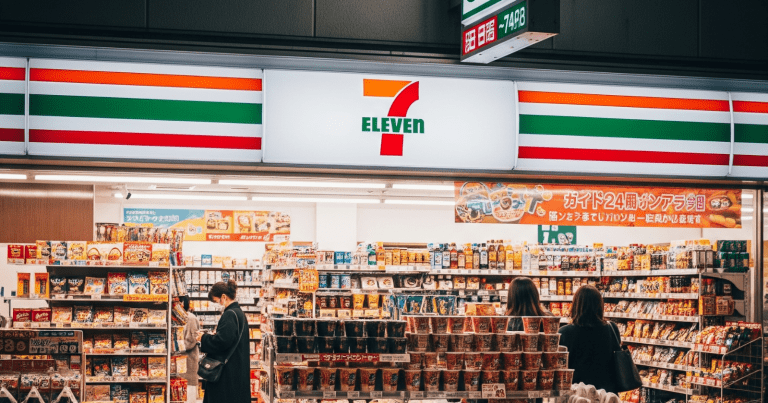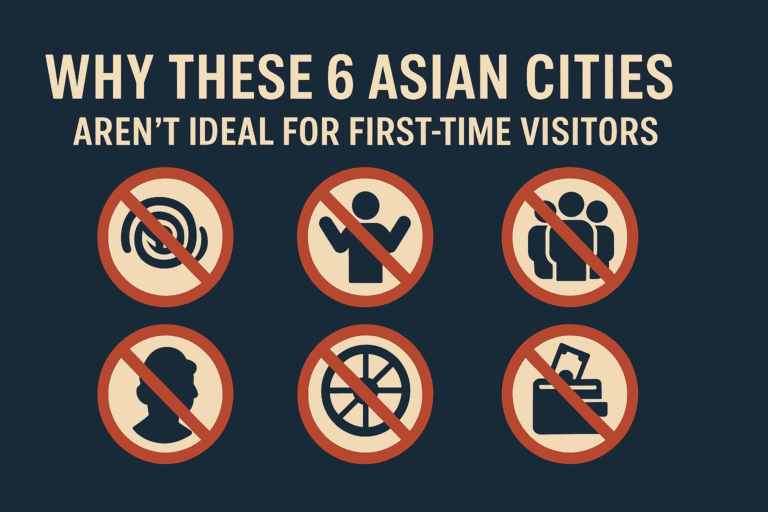
Ready to explore Hokkaido beyond the main city hubs? While Japan’s public transport is legendary, depending solely on trains and buses in Hokkaido means you’ll miss out on hidden gems and breathtaking scenery only accessible on your own schedule.
When my partner and I planned our 16-day Japan adventure – split between Tokyo, Hokkaido, and Osaka – we initially underestimated Hokkaido. We knew it was Japan’s northern frontier, famous for snow and skiing, but little else. Our six days there turned into the highlight, thanks in large part to one decision that completely beat our expectations: Renting a car in Hokkaido.
Forget rigid train schedules or crowded tour buses. This is about giving you the freedom to discover Hokkaido’s vast landscapes at your own pace, stopping whenever a stunning view or a tempting local cafe calls your name. Based on our experience navigating Sapporo, Lake Toya, Furano, and everything in between, I’m sharing the actionable insights you need to decide if a Hokkaido road trip is right for you and how to pull it off smoothly.
Core Tips: Why a Car Changes Everything in Hokkaido & Getting Started
Hokkaido is big. Really big. Unlike the compact, hyper-connected cities like Tokyo or Osaka where public transport is king, venturing outside Sapporo quickly reveals the limitations of relying on trains and buses. Distances between major attractions like lakes, national parks, and charming rural towns are significant, and train lines are sparse in many areas. Buses exist, but they can be infrequent, especially off the main routes, and often require frustrating transfers. This is where renting a car isn’t just convenient; it’s transformative for exploring the real Hokkaido.
The most crucial first step for many foreign visitors wanting to drive in Japan is dealing with the driver’s license. Japan has specific requirements. You’ll likely need either an International Driving Permit (IDP) issued in your home country before you leave, or if you’re from certain countries (like Switzerland, Germany, France, Belgium, Taiwan, or Monaco), an official Japanese translation of your domestic license. Our case fell into the latter category.
My partner needed a translation. This sounds complex, but it’s surprisingly straightforward. We simply used an online service recommended by the Japanese Automobile Federation (JAF) to get the translation document digitally. Then, handily, we printed it out at a 7/11 convenience store upon arrival in Japan before heading to Hokkaido. This simple step took less than an hour and was essential for picking up the car. Always check the specific requirements for your nationality well in advance on the JAF website or your country’s embassy in Japan.
 Once you have the necessary paperwork, picking up the car is standard procedure. We booked with Orix, a reputable Japanese company, and found the process efficient and the vehicle clean and well-maintained. But the real revelation came when we hit the road. Japanese drivers are incredibly disciplined and courteous. This isn’t the chaotic driving you might expect in some parts of Asia. They obey speed limits, yield appropriately, and signal generously. This makes driving stress-free, even for those initially nervous about driving in a foreign country. The roads themselves are also excellent – wide, well-paved, and clearly signposted (often with English translations). Navigating felt intuitive thanks to good GPS systems (more on that later) and the sheer quality of the infrastructure.
Once you have the necessary paperwork, picking up the car is standard procedure. We booked with Orix, a reputable Japanese company, and found the process efficient and the vehicle clean and well-maintained. But the real revelation came when we hit the road. Japanese drivers are incredibly disciplined and courteous. This isn’t the chaotic driving you might expect in some parts of Asia. They obey speed limits, yield appropriately, and signal generously. This makes driving stress-free, even for those initially nervous about driving in a foreign country. The roads themselves are also excellent – wide, well-paved, and clearly signposted (often with English translations). Navigating felt intuitive thanks to good GPS systems (more on that later) and the sheer quality of the infrastructure.
Our itinerary had us spend two nights in Sapporo first. We found it a lively city, buzzing but noticeably less overwhelming than Tokyo. We indulged in incredible food – the best soft-serve ice cream we’ve ever tasted and unforgettable Genghis Khan lamb grill. After exploring Sapporo, we checked out, walked a short distance to the Orix branch, completed the pickup, and bam – freedom!
We immediately pointed the car south. The drive out of Sapporo was easy, and soon we were surrounded by sprawling landscapes. The ability to stop whenever we wanted was clutch. Driving towards Lake Toya, we pulled over countless times just to soak in views of Mount Yotei from different angles. These weren’t designated viewpoints sometimes, just wide shoulders or small parking areas that you’d totally miss on a bus. This simple freedom to pause and appreciate the scenery on our own timeline was the first major indicator that the car rental was paying off big time.
Advanced Tactics: Booking Smart, Navigation, and Road Essentials
Booking your car rental in advance is crucial, especially during peak seasons like summer (Furano flower fields) or winter (ski season). While you might find last-minute options, popular vehicle types or specific rental periods can book out. Comparing prices online across major Japanese rental companies like Toyota Rent a Car, Nippon Rent-A-Car, Orix, and Times Car Rental is a good strategy. Use aggregate sites, but also check the company websites directly for specific deals or vehicle types. Pay close attention to pick-up and drop-off locations – renting in Sapporo and dropping off in a different city might incur a one-way fee, but it can be worth it depending on your overall itinerary flow.
Insurance is another critical factor. Standard Japanese rental car insurance usually covers basic damage and liability, but the deductibles (Collision Damage Waiver – CDW) can still be high. Companies will offer optional coverage to waive these deductibles (often called ‘Exempting Liability’ or similar). Always take this coverage. The small daily fee is well worth the peace of mind, protecting you from potentially large expenses even for minor scrapes. Consider additional options like Non-Operation Charges (NOC) coverage, which pays the rental company for lost revenue if the car is being repaired. Given the relatively low cost of driving in Japan compared to other developed countries, skimping on insurance isn’t a savvy traveler move.
Navigating in Japan is generally excellent thanks to widespread GPS usage. Rental cars usually come with built-in navigation systems. While these are often in Japanese, you can usually switch the voice guidance to English and input destinations using phone numbers or map codes (unique codes assigned to specific locations, often found on attraction websites or tourist maps). Using a map code is often more precise than trying to input addresses, especially for smaller attractions or specific viewpoints. Supplementing the in-car GPS with your smartphone using Google Maps or Maps.me is also wise. Ensure you have a reliable data connection (a local SIM or eSIM is best) or download offline maps for areas with spotty coverage. I highly recommend downloading an offline map of Hokkaido onto your phone before you go – it saved us when we ventured into more remote areas with weak signals.
 One aspect often overlooked is parking. In cities like Sapporo, parking can be expensive, similar to major global cities, often costing several hundred yen per hour. Look for parking garages (often marked with a blue P) or coin-operated lots. In smaller towns and at most tourist attractions in rural Hokkaido (like national parks or viewpoints), parking is usually free or a very small flat fee. When we stayed near Lake Toya, our ‘trailer-like hotel’ had free parking right next to our unit, which was incredibly convenient. This is a stark contrast to trying to find affordable overnight parking in a dense city like Tokyo.
One aspect often overlooked is parking. In cities like Sapporo, parking can be expensive, similar to major global cities, often costing several hundred yen per hour. Look for parking garages (often marked with a blue P) or coin-operated lots. In smaller towns and at most tourist attractions in rural Hokkaido (like national parks or viewpoints), parking is usually free or a very small flat fee. When we stayed near Lake Toya, our ‘trailer-like hotel’ had free parking right next to our unit, which was incredibly convenient. This is a stark contrast to trying to find affordable overnight parking in a dense city like Tokyo.
Toll roads are common in Japan, particularly for efficient long-distance travel. You’ll encounter them when driving between major cities or towards popular destinations. The most convenient way to pay is using an Electronic Toll Collection (ETC) card. You can usually rent an ETC card with your car. This allows you to pass through ETC gates without stopping to pay cash, and the tolls are calculated and charged to the card later. It’s not always cheaper, but it significantly speeds up journeys on expressways. The alternative is paying cash at manned booths, which is slower but straightforward. Factor toll costs into your budget, especially for longer drives.
Seasonality is a major consideration in Hokkaido. While our trip was outside the peak winter snow season, it’s essential to be prepared if you’re visiting then. Winter driving requires specific skills and vehicle preparation (studless tires are mandatory by law in winter and will be fitted by the rental company). Road closures due to heavy snow are common, and driving conditions can be hazardous. If you’re not experienced with driving in snow and ice, renting a car in Hokkaido in winter might be best left to those who are, or you should stick to areas well-serviced by public transport. However, outside of deep winter, driving is generally very pleasant.
Fueling up is simple. Gas stations are widespread, though perhaps less so in truly remote areas. Most stations are self-service (セルフ or SELF). Pumps are often color-coded (red for regular, yellow for high octane, green for diesel). Payment is usually by credit card or cash at the pump or inside. If you’re unsure, look for stations marked “Full Service” (フルサービス or フル), though these are becoming less common. Always check the fuel type your rental car uses.
One thing that truly stood out during our drive from Lake Toya up towards Furano was the sheer beauty accessible just off the road. We stopped for two hours at a viewpoint in Shikotsu-Toya National Park simply because we could. The flexibility to spontaneously explore national parks, small roadside cafes (like the one near Lake Toya with the amazing iced coffee latte), or just a particularly stunning stretch of highway scenery is the core advantage of having your own vehicle in Hokkaido. Public transport simply can’t offer that level of spontaneity and access.
Niche Tips: Unlocking Hidden Experiences & Resources
Beyond the obvious navigation apps, consider apps or websites focused on specific interests. For finding those charming, hidden cafes or local restaurants in smaller towns, Japanese-language review sites like Tabelog (which you can often navigate with Google Translate) can be invaluable and much better than relying solely on international platforms. While our overnight stay near Lake Toya was quiet with just a few restaurants, having the car meant we could easily drive a few minutes to find exactly what we were looking for, rather than being limited to options within walking distance of a train station.
For finding the best spots for landscape photography or unique viewpoints, searching online forums, local travel blogs (often found by searching in Japanese and translating), or even Instagram hashtags can yield locations that aren’t marked on standard tourist maps but are easily reachable with a car. This is how you move from seeing the same famous sights as everyone else to discovering your own slice of Hokkaido’s magic.
Planning your route with driving time estimates is key, but factor in plenty of extra time for unplanned stops. Those moments pulling over to admire Mount Yotei or spontaneously spending two hours exploring a national park are the highlights of a Hokkaido road trip. Don’t overschedule yourself. We quickly realized that the “travel time” included in online maps was just driving time; the real joy was in the stops along the way. This flexibility is a major perk when you’re not beholden to a bus schedule.
For real-time road conditions, especially if traveling outside the main summer months, rely on official Japanese sources. The Japan Road Traffic Information Center (JARTIC) website provides up-to-date information on traffic jams, closures, and road conditions. While primarily in Japanese, translation tools can help, and major rental companies often have resources or staff who can advise on routes and conditions. For winter travel, this is non-negotiable knowledge.
Utilizing convenience stores like 7/11 or FamilyMart goes beyond just printing documents. They are excellent for grabbing snacks, drinks, and even simple meals on the go, which is perfect for road trips where dining options might be sparse between towns. They also have ATMs that accept foreign cards, making cash access easy. Think of them as mini-travel hubs.
One aspect that truly cemented our feeling that renting a car was the best decision was the value for money outside of Sapporo. While Sapporo had great food at reasonable prices, venturing into the rural areas towards Lake Toya and Furano revealed excellent, cheap local restaurants that we wouldn’t have easily reached without the car. The flexibility to explore smaller towns led us to some incredibly delicious and affordable meals, contributing significantly to keeping our overall trip budget in check.
Having a car also makes staying in more unique or remote accommodations feasible, like our trailer hotel near Lake Toya or an apartment rental in Furano. These places often offer better value or a different experience than city hotels but require personal transport to access. This opens up options beyond typical tourist areas, allowing for a deeper connection with the local environment and culture. For budget travelers, this can mean finding more affordable or interesting places to stay off the main transport lines, similar to seeking out Southeast Asian islands for budget backpackers.
Thinking strategically about your travel style is key. Are you someone who loves spontaneous detours, prefers quiet natural scenery over city buzz, and values the freedom to control your schedule? If so, a car in Hokkaido is likely a game-changer. If you prefer sticking to major cities and well-worn tourist paths, public transport might suffice. But for truly experiencing the breadth and beauty of Hokkaido’s nature, a car is unparalleled. It’s about embracing the journey as much as the destination, a philosophy that applies whether you’re navigating the roads of Japan or finding your way through the bustling markets of Malaysia.
Accessing remote areas isn’t just about viewpoints; it’s also about activities. Many of Hokkaido’s best natural attractions – hiking trails, hot springs (onsen) tucked away in the mountains, even some of the most scenic farms and flower fields in areas like Furano – are located a distance from train stations. A car gives you direct access, maximizing your time enjoying the activity rather than commuting to it.
Finally, remember the small practicalities. Keep some cash handy for smaller tolls or parking lots that don’t accept cards. Make sure your phone is charged or you have a power bank, as it will be your essential co-pilot for navigation and information. And always double-check the fuel type before filling up – mixing them up is a costly mistake!
One last thought: don’t be intimidated by the idea of driving in Japan. The rules are clear, enforcement is fair, and the infrastructure is top-notch. With the right preparation regarding your license and booking insurance, it’s arguably one of the easiest and most pleasant countries in Asia to undertake a road trip. It transformed our perception of Hokkaido from just a “cold place with skiing” to a region of incredible natural beauty, welcoming towns, and endless exploration potential, proving that sometimes the best travel experiences come when you take the road less traveled.
Conclusion: Your Hokkaido Freedom Awaits
Our Hokkaido adventure proved that sometimes the most rewarding travel decisions are the ones that grant you ultimate flexibility. Renting a car in Hokkaido wasn’t just about getting from point A to point B; it was about the freedom to stop for unexpected views of Mount Yotei, linger by Lake Toya, spontaneously explore Shikotsu-Toya National Park, and discover charming, affordable eateries off the beaten path. The straightforward process of license translation, combined with Japan’s disciplined driving culture and excellent roads, made the experience far easier and more enjoyable than anticipated.
Empower yourself with these practical tips, and you’ll find that exploring Hokkaido by car opens up possibilities you simply wouldn’t have otherwise. It transforms a trip from a structured itinerary into a genuine adventure of discovery. Our expectations were beaten, and yours can be too.


